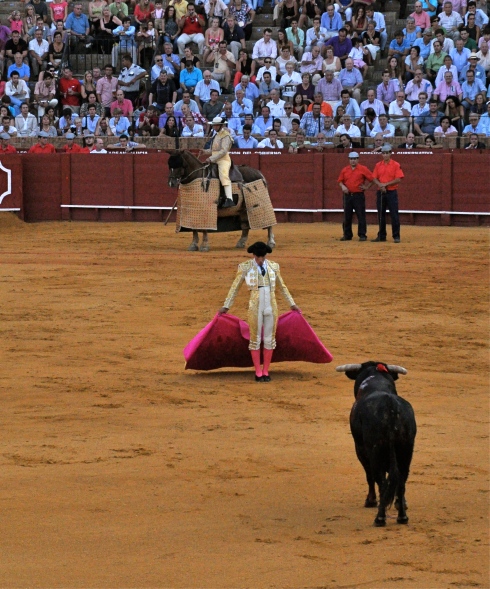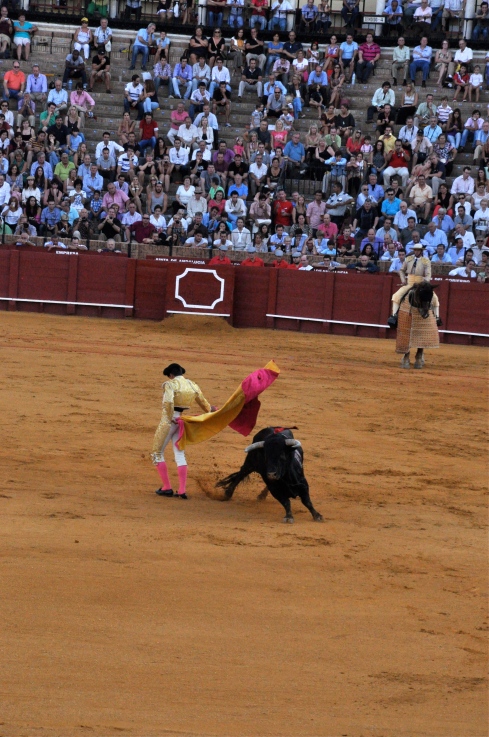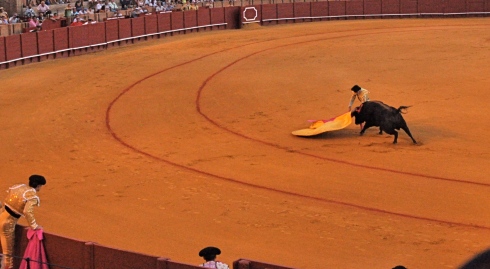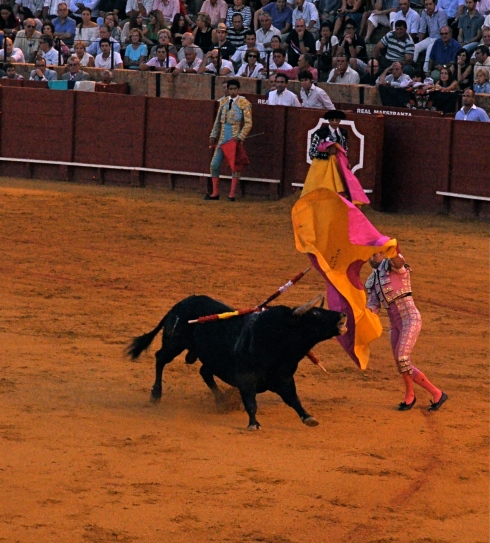“It’s a once in a lifetime experience. You have to go,” I told myself over and over again as I walked in the heat of the day to buy tickets to my first (and most likely, last) bullfight. Despite my indecisiveness about the sport, my friends and I had looked into going prior to this day but tickets were going for seventy euro, which is a tad out of my price range. I had given up hope until I heard a “Lindsie! Guess what!” at the entrance of the coffee shop where I was earnestly studying (obviously) on a Sunday afternoon. By some miracle, most likely because it was an amateur match; my friends had found tickets for 13 euro. I was sold instantly and within minutes was on my way to un corrido.
Upon arrival, it is transparent that this sport truly holds significance in the heart of the Spaniards. Stone pews encircle the ring in overlapping strands to hold hundreds of bullfighting fans who look down upon what can only be the reddest sand I’ve ever seen while three flags, with Spain’s at the center, fly above the focal point of the ring. The architecture is magnificent and one of the most beautiful buildings I have seen since I’ve been here in Sevilla.
Excitement bubbled up inside of me when music from the brass band began to play. After a traditional opening ceremony introducing the players and assistants on board, the matadors took their place. The audience was silenced along with the muted band and a single trumpet began to play a dubious solo, turning the attention to the banging and kicking heard against the walls of one of the entrances to the ring. The music stopped and heavy footsteps were heard as the bull rushed into the ring.
The games had started.
The first bull was smaller but rambunctious to say the least. Numerous matadors welcomed him to the ring and fired him up, enticing him this way and that by the motion of their neon pink flags. A solo trumpet was heard once again and the doors to a larger entrance swung open. Two blindfolded and thoroughly armored horses crossed into the threshold, their riders ready with swords? What was about to occur became, by far, my least favorite part of the bullfight. Luring the bull toward the horses, the well protected riders? Stabbed the bull from above, once, twice, three times. Lifting both the horse and its guest, the furious bull, lashed back by attempting to gore the horse in the underbelly. I was thankful to see (and hear) that the horse was wearing metal plates around its belly and was not frightened because he could not see. The morality in this may be sketchy, but I was at least happy not to see another innocent animal die.
After the horses were called back in, the artistic performance began. The matador, dressed in a gold, glittery outfit topped off with pink socks, raised his cap to the audience and faced his opponent. With the flick of his wrist, the bright red flag swayed and the bull came galloping forward. Simultaneously moving the flag and contorting his body into the shape of a C, the matador lead the bull under the flag and around his body. “¡Olé!” Came a shout from the crowd and I finally began to understand the allure of a bullfight.
Three matadors performed, fighting two bulls each. The first bull conquered is an indication of the bullfighter’s masculinity, the second a confirmation. In terms of masculinity; however, I believe matadors would give ballerinas a run for their money. The performance is as much an art form, as it is a sport. In fact, many Spaniards argue that it is simply an art. The matador is constantly seducing the bull; tiptoeing toward and away from the fellow performer. The duet is constant, a dance that ushers the artists to flow together in fluid motions. Spontaneity, in form of the bull, ensures the talent of the matador and how softly he can control the beast, caressing him, blood and all to prove his gift.
The tango ends in one final thrust of the sword down the mighty bull’s heart. An attempt to fight back is always given by the wounded, but not for long. The jumps are discontinued, the swift movement of the matador less necessary and the twirls a little slower until finally, the bull’s life comes to an end.
It is, almost, like a tragic love story. Almost.
Watching the entirety of the performance is hard yet intriguing. Like a train wreck, you don’t want to see yet you cannot look away. The glass in the lens of my camera served to be a shield from reality, the more I took pictures, the easier it was to handle. This method worked until one matador was thrown into the air and suddenly morality set in, “do I take pictures? Do I stop taking pictures? This is really happening… I am staring at a man about to be trampled by a large, ferocious bull.” Consequently, choices were not at hand as shock set in first and the camera came back down around my neck. Hopefully this didn’t keep me from an award-winning photo. (By the way, the matador was fine… just a little too bold in my opinion.)
As I walked away, increasingly insensitive to the six bulls that I watched die, I found myself more in question of the morality than mourning over the animals. Thank goodness for my Spanish civilization class. The bulls bodies are still in good shape after their death, therefore, the meat goes to use as well as most of the carcass. Bull’s tail is a common tapa around Andalusia, though I have yet to try it. There is also one situation in which both the matador and the bull live. If and when the bull and matador are such courageous and bold fighters that neither give up, the audience can request that the bull live. With this comes no shame on part of the matador because he has come across an equally strong performer and the two danced beautifully. The matador’s masculinity comes with the fact that he has not been gored to death. This occasion is rare, but the bull goes back to its peaceful, open range farm where it procreates for the rest of its life… a type of reward, if you will, and to produce more bulls like it while the matador becomes a large celebrity.
Maybe there is an ideal goodness in bullfighting? Then again, maybe not….











